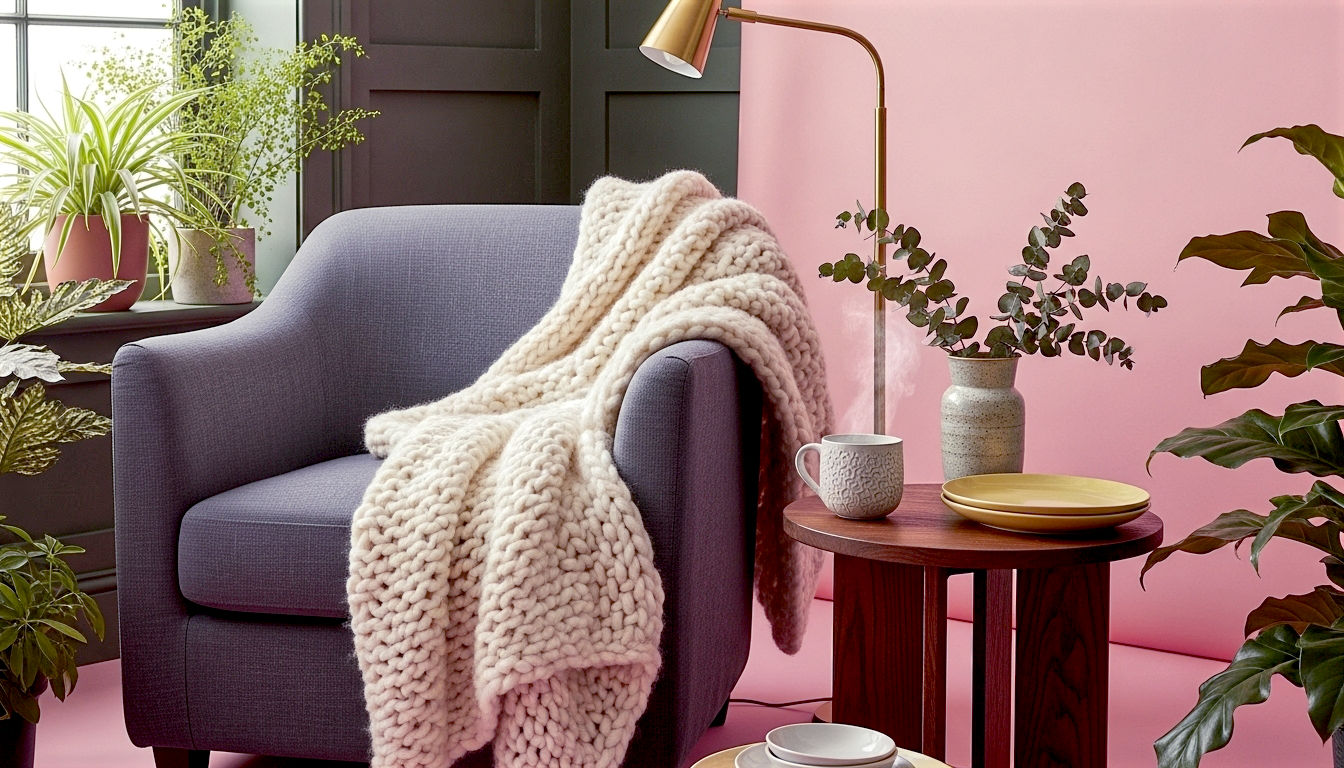Beyond Colour: The Guide to Using Texture in British Home Decor
Go beyond colour and learn the interior designer’s secret weapon: texture. This definitive guide covers everything from layering fabrics to choosing materials for a home with soul.

This post may contain affiliate links. If you make a purchase through these links, we may earn a commission at no additional cost to you.
Walk into a room that feels instantly welcoming, a space where you just want to curl up and stay a while. Now, think about a room that feels cold, flat, and a bit… well, boring. The difference often isn’t the colour on the walls or the style of the furniture. It’s something you feel as much as you see. It’s texture.
Texture is the unsung hero of interior design. It’s the secret ingredient that turns a collection of nice things into a warm, inviting home. It’s the fuzzy blanket you pull over yourself on a chilly evening, the cool smoothness of a marble kitchen worktop, and the rough grain of an old wooden dining table. In Britain, where we cherish our cosy cottages, elegant townhouses, and stylish city flats, understanding texture is the key to creating a home with real soul.
This guide will take you through everything you need to know. We’ll explore what texture actually is, why our brains love it so much, and how you can use it like a pro in every single room. Forget feeling overwhelmed; think of this as a friendly chat about making your home feel as good as it looks.
What Exactly Is Texture in Home Decor?
In simple terms, texture is all about how a surface feels, or how it looks like it would feel. It’s a feast for the senses, primarily touch and sight. In the world of design, we split it into two main types: tactile and visual.
Tactile Texture: What You Can Actually Touch
This is the most obvious kind of texture. It’s the physical feeling of a surface when you run your hand over it. Is it rough or smooth? Soft or hard? Bumpy or sleek?
Think about the different tactile textures in your home right now:
- Soft: The plush pile of a velvet cushion, a fluffy sheepskin rug, or a soft-to-the-touch cashmere throw.
- Rough: The scratchy feel of a sisal carpet, the uneven surface of a slate hearth, or the rustic finish of a reclaimed wooden beam.
- Smooth: The cool, polished surface of a granite worktop, the sleekness of a glass coffee table, or the glossy finish on a painted door.
- Hard: The solid feel of a brick wall, a ceramic tile, or a metal lamp base.
These textures have a powerful effect. Soft textures make us feel comfortable and safe, while rough, natural textures can connect us to the outdoors. Smooth, hard textures often feel clean, modern, and sophisticated.
Visual Texture: A Feast for the Eyes
Visual texture is a clever trick. It’s the illusion of a physical texture created by a pattern, material, or finish. You don’t have to touch it to understand how it might feel. It’s all about creating interest and stopping a surface from looking flat.
Examples are everywhere once you start looking for them:
- Wood Grain: A piece of oak furniture has visual texture from its distinctive grain. You can see the lines and patterns, which gives it depth even if it’s been polished to a smooth finish.
- Patterned Wallpaper: A wallpaper with a botanical print or a geometric design creates immense visual texture. Your eye is drawn to the repeating pattern, which adds life to a plain wall.
- Woven Fabrics: The weave of a linen curtain or a tweed sofa creates a subtle pattern. You can see the criss-cross of the threads, which gives it a sense of texture from across the room.
- Marble and Stone: The veining in a piece of marble is a classic example of visual texture. It breaks up the surface and adds a sense of movement and luxury.
The best-designed rooms use a mix of both tactile and visual textures. A smooth leather sofa (tactile) might be decorated with patterned cushions (visual), and placed on a rug with a visible weave (both!).
The Psychology of Touch: Why Texture Makes a House a Home
Have you ever wondered why we instinctively reach out to touch things? Our sense of touch is deeply connected to our emotions and our sense of security. Using texture in our homes taps into this primal instinct, and it has a profound psychological impact.
Creating Comfort and Cosiness
This is texture’s superpower, especially in the often-grey British climate. Soft, warm, and plush textures send a signal to our brains to relax. They remind us of warmth and safety. This is why a chunky knit blanket, a deep-pile rug, or a soft boucle armchair feels so incredibly inviting. They make a space feel like a sanctuary – a place to escape from the hustle and bustle of the world. It’s the very essence of creating a cosy, welcoming atmosphere.
Adding Depth and Interest
A room decorated in a single colour with no textural variation can feel incredibly dull and one-dimensional. Texture is what gives a space its personality and depth. It breaks up surfaces and creates subtle highlights and shadows.
Imagine a living room painted entirely in a neutral beige. If the sofa is beige, the carpet is beige, and the curtains are beige, the room will feel lifeless. But now, imagine that same room with a boucle sofa, a jute rug, linen curtains, and a rough-hewn wooden coffee table. Even though the colours are the same, the room is suddenly interesting, layered, and sophisticated. The different textures catch the light in different ways, adding subtle complexity and drawing you in.
Balancing a Room’s Energy
Texture is also a master of balance. Interior design is all about creating harmony, and that often means pairing opposites. A room with too many smooth, sleek surfaces (like glass, chrome, and high-gloss paint) can feel cold and clinical. By adding some rough or soft textures – a woolly rug, some rustic pottery, or a wooden side table – you introduce warmth and ground the space.
Conversely, a room with too many rustic, rough textures can feel a bit chaotic or heavy. Introducing a few smooth elements, like a marble lamp base or a silk cushion, can add a touch of elegance and refinement, making the space feel more balanced and intentional. It’s a delicate dance between different surfaces.
The Grand Tour: Using Texture in Every Room
The principles of texture can be applied to any space in your home, from the busiest family living room to the smallest bathroom. Here’s a room-by-room guide to getting it right.
The Living Room: Your Cosy Haven
The living room is where we relax and socialise, so it’s the perfect place to go big with texture. The goal is to create a space that’s comfortable, inviting, and full of character. Layering is your best friend here.
- Start from the ground up: A large rug is a fantastic way to anchor the room and add a huge dose of texture. A natural fibre rug like jute or sisal adds a rustic, earthy feel, while a thick wool or shag pile rug feels much more luxurious and cosy.
- The sofa is key: Your sofa’s material sets the tone. A classic British Chesterfield in aged leather adds a sense of history and warmth. A modern sofa in a soft linen feels relaxed and informal, while one in rich velvet adds a touch of glamour.
- Layer on the soft stuff: This is the fun part! Pile on cushions and throws in a variety of materials. Don’t be afraid to mix and match. Pair a smooth silk cushion with a chunky knit one, or a faux fur throw with linen pillows.
- Mix your materials: Combine different textures across your furniture and accessories. A rough-sawn wooden coffee table can look fantastic next to a sleek metal floor lamp. A smooth ceramic vase filled with dried, feathery pampas grass is a perfect example of textural contrast.
The Bedroom: A Serene Sanctuary
In the bedroom, the focus should be on creating a calm, peaceful environment that promotes rest. This means leaning into soft, soothing, and luxurious textures.
- Beautiful bedding: The bed is the focal point, so invest in high-quality bedding. Washed linen is a popular choice in the UK for its relaxed, slightly crumpled look and beautiful feel. Crisp cotton percale feels cool and fresh, while bamboo fabric is incredibly soft. Layer it up with a waffle-weave blanket or a quilted bedspread for extra textural interest.
- Softness underfoot: There’s nothing worse than stepping out of a warm bed onto a cold, hard floor. A pair of soft, deep-pile rugs on either side of the bed will make your mornings that little bit nicer.
- Frame the windows: Curtains can add a huge amount of softness to a bedroom. Heavy, blackout-lined curtains in a material like velvet or a thick wool blend will not only block out light but also help to absorb sound, making the room feel more peaceful.
- Consider a headboard: An upholstered headboard in a soft fabric like linen, velvet, or boucle can make your bed feel much more comfortable and luxurious.
The Kitchen: Where Practicality Meets Personality
The kitchen is full of hard, practical surfaces – worktops, cabinets, appliances. This makes it a prime candidate for a bit of textural TLC to stop it from feeling too sterile.
- Worktop wonders: Your worktop is a major textural statement. A polished granite or quartz is sleek and modern, while a wooden worktop adds instant warmth and a more rustic, country-kitchen feel.
- Tactile tiles: The splashback is a brilliant opportunity to play with texture. Handmade Zellige tiles have an uneven, glossy surface that reflects light beautifully. A textured stone or slate tile can add a dramatic, earthy feel.
- Natural touches: Bring in natural materials to soften the hard edges. Use wooden chopping boards, display fruit in a woven rattan bowl, and place a small ceramic pot with fresh herbs on the windowsill.
- Hardware matters: Don’t forget the details! Swapping standard cabinet handles for something more textural, like knurled brass knobs or aged leather pulls, can make a huge difference.
The Bathroom: A Spa-Like Escape
You can easily turn a functional bathroom into a relaxing, spa-like retreat by carefully choosing your textures.
- Play with tiles: Use tiles to create contrast. You could have large-format, smooth tiles on the floor and smaller, textured tiles in the shower enclosure. A feature wall of 3D or ribbed tiles can add a real wow factor.
- Warm it up with wood: Water-resistant woods like teak or bamboo can add a much-needed touch of warmth. Think of a wooden bathmat, a small stool, or some storage crates.
- Luxurious linens: Invest in the best towels you can afford. A stack of fluffy, high-quality cotton towels instantly makes a bathroom feel more luxurious.
- Accessorise with nature: A bit of natural stone, such as a marble soap dish or a slate tray, can add a touch of organic elegance. And don’t forget a plant – the glossy leaves of a peace lily or the trailing stems of an ivy can soften the whole space.
A Designer’s Toolkit: Key Textures and How to Use Them
Ready to start experimenting? Here are some of the most effective textural elements and how you can incorporate them into your home.
Soft Furnishings: The Easiest Way to Add Texture
This is the simplest and most affordable way to dip your toe into the world of texture.
- Cushions and Throws: These are your textural workhorses. You can change them with the seasons – light linens and cottons in summer, cosy wools, velvets, and faux furs in winter. Mix different shapes, sizes, and materials on your sofa or bed for a rich, layered look.
- Curtains and Blinds: The fabric you choose for your window treatments has a big impact. Sheer, floaty voiles will diffuse light beautifully and add a sense of airiness. Heavier fabrics like wool or tweed feel substantial and cosy, perfect for a British living room. A woven bamboo or wood blind adds a lovely natural texture.
- Rugs and Carpets: The right rug can completely transform a room. Natural fibres like jute and seagrass are durable and bring a relaxed, coastal vibe. Wool is a classic choice – it’s soft, hard-wearing, and feels wonderful underfoot. A vintage Persian-style rug adds both visual texture (from its pattern) and tactile texture.
Furniture: More Than Just a Place to Sit
The materials your furniture is made from are fundamental to your home’s textural palette.
- Wood: An incredibly versatile material. A piece of furniture made from reclaimed, weathered wood with a prominent grain will add a rustic, industrial feel. A piece made from a dark, polished wood like walnut or mahogany feels more traditional and refined. Lighter woods like oak and ash are staples of Scandinavian design and feel calm and natural.
- Metal: Metal can be used to add a touch of shine and contrast. A brushed brass or gold finish feels warm and glamorous. Blackened steel or iron has a more industrial, edgy look. Polished chrome is cool and modern.
- Upholstery: This is where you can get really creative.
- Boucle: This looped, fleecy fabric is hugely popular right now and adds a soft, cuddly texture that’s pure comfort.
- Velvet: Rich, luxurious, and beautiful to touch. It catches the light in a unique way, adding a sense of drama and sophistication.
- Linen: Relaxed, breathable, and effortlessly chic. Its natural, slightly crumpled look is perfect for a more informal style.
- Leather: A timeless classic that gets better with age. It can be sleek and modern or worn and vintage, and it provides a wonderful smooth contrast to softer fabrics.
Walls and Floors: The Canvas of Your Home
Don’t forget the biggest surfaces in the room!
- Paint Finishes: Even paint has texture. A matte or chalky finish has a soft, velvety look that absorbs light, perfect for creating a cosy atmosphere. An eggshell or satin finish has a slight sheen that’s more durable and reflects a little light. A high-gloss finish is very dramatic and reflective, adding a dose of glamour.
- Wallpaper: Wallpaper offers endless possibilities for visual texture. Grasscloth wallpaper is made from natural fibres and adds a subtle, organic texture. An embossed or flock wallpaper has a raised pattern you can feel, adding a sense of traditional luxury.
- Tiling and Panelling: Adding panelling to a wall is a brilliant way to introduce architectural interest and subtle texture. In a bathroom or kitchen, textured tiles can turn a plain surface into a stunning feature.
Accessories and Nature: The Finishing Touches
The small details are what pull a textural scheme together.
- Plants and Flowers: Nothing beats the texture of nature. The waxy leaves of a succulent, the feathery fronds of a fern, the soft petals of a rose – plants add life, colour, and organic texture to any room. Dried flowers and grasses are also a wonderful, long-lasting option.
- Ceramics, Glass, and Stone: Grouping accessories with different textures creates beautiful little vignettes. A collection of rustic, matte-finish ceramic vases on a smooth wooden shelf looks fantastic. A heavy marble ornament next to a delicate glass candle holder provides a lovely contrast.
Finding Your Style: Texture in Different Design Schemes
Texture is a vital component of every single interior design style. The key is simply choosing the right textures to create the look you want.
Minimalist and Scandinavian: Subtle and Sophisticated
Minimalism isn’t about being cold or empty; it’s about carefully choosing every element. Texture is crucial for adding warmth and preventing a minimalist space from feeling stark.
- Key Textures: Light-coloured woods (oak, ash), soft wools, linen, leather, felt, and ceramics. The focus is on natural, high-quality materials.
- How to Use It: Layer different shades of white, grey, and beige using different materials. A white linen sofa on a light oak floor, topped with a grey wool throw, is a classic Scandi look.
Industrial: Raw and Unrefined
The industrial style celebrates the beauty of raw, functional materials. It’s all about embracing imperfections.
- Key Textures: Exposed brick, concrete, raw wood, aged leather, and metals like steel and iron.
- How to Use It: Contrast is key. Soften a rough brick wall and a concrete floor with a large, worn leather sofa and a soft, low-pile rug to make the space feel liveable and inviting.
Bohemian and Eclectic: A Global Tapestry
This style is all about freedom, creativity, and layering. More is more when it comes to texture in a bohemian home.
- Key Textures: Macrame, rattan, seagrass, globally-inspired textiles with lots of pattern and tassels, sheepskin, and a jungle of houseplants.
- How to Use It: Layer, layer, layer! Put a patterned rug on top of a larger jute one. Pile a sofa high with cushions from different parts of the world. Hang a macrame wall hanging and fill every corner with plants.
Classic British and Country: Timeless and Cosy
This style takes inspiration from grand country houses and charming cottages. It’s about comfort, tradition, and a connection to the landscape.
- Key Textures: Heritage fabrics like tweed, tartan, and wool. Aged leather, particularly on a classic Chesterfield sofa. Dark, polished wood, chunky knits, and floral chintz.
- How to Use It: Think of a cosy pub or a library in a stately home. Pair a leather armchair with a tartan wool blanket. Use floral linen curtains and place a solid oak coffee table on a traditional patterned rug.
Common Pitfalls: How to Avoid a Textural Tangle
While it’s hard to go too wrong with texture, there are a few things to keep in mind.
- Overdoing It: While layering is good, too many competing textures in one small space can feel chaotic and cluttered. Try to stick to three or four main textures in a room and repeat them to create a sense of cohesion.
- Forgetting Scale: Pay attention to the scale of your textures. A tiny, subtle pattern will get lost in a large room, while a very bold, large-scale texture (like a huge chunky knit) might overwhelm a small space.
- Ignoring the Overall Mood: Always think about the feeling you want to create. If you’re aiming for a calm, serene bedroom, avoid too many jarring, rough textures. If you want a vibrant, energetic living room, a single, smooth texture won’t be enough.
Conclusion: Start Your Own Textural Adventure
Texture is the silent storyteller of your home. It’s what makes a space feel uniquely yours. It’s the difference between a house that looks like it’s from a catalogue and a home that feels lived-in, loved, and full of personality.
The best part is that you don’t need to be an interior designer or spend a fortune to start using it. The journey can begin with something as simple as a new cushion or a soft throw blanket.
So next time you’re in a room, close your eyes for a moment. What do you feel? The soft fabric of the sofa? The cool wood of the floor? The rough texture of the wall? Start paying attention to the textures around you, and you’ll soon be able to speak the secret language of your home, creating spaces that don’t just look good, but feel truly wonderful.
Further Reading
For more inspiration on British interiors and the use of texture, explore these highly respected resources:
- Elle Decoration UK: A leading voice in style, design, and interiors.
- Livingetc: A fantastic source for modern design ideas and home tours.
- Mad About The House: An award-winning blog by journalist Kate Watson-Smyth, full of practical advice and inspiration.
- The White Company: Masters of serene, textural, and neutral-toned homeware.






